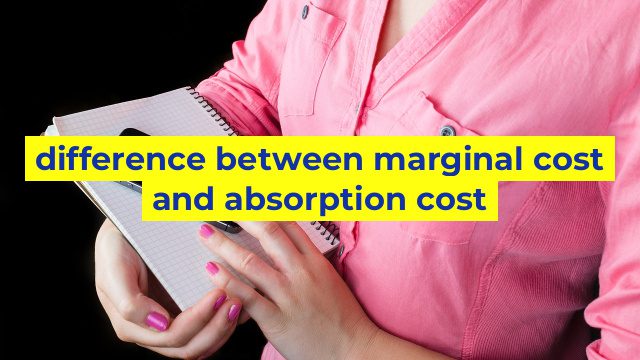The Important Difference Between Marginal Cost and Absorption Cost
Cost accounting is essential for businesses to make informed decisions regarding their financial performance. There are various cost accounting methods available, but two crucial methods that every business owner should understand are marginal cost and absorption cost. These methods help in understanding the periodic costs of producing and selling products, and determining the profitability of the business. Here is a brief explanation of marginal cost and absorption cost and the difference between the two.
Marginal Cost
Marginal cost is the additional cost incurred while producing an additional unit of a product. It includes direct costs, such as direct labor, direct material, and other variable costs. The marginal cost calculation is essential to analyze the impact of incremental or decremental production changes, such as changes in production volumes, or the introduction of new production lines or products.
For example, suppose a manufacturing company produces 10 units of a product and incurs a total cost of $10,000. If the firm decides to produce 11 units, including the variable cost of producing the additional unit, the marginal cost will be the cost of producing the 11th unit minus the cost incurred while producing the initial 10 units.
Absorption Cost
Absorption cost is the sum of all variable and fixed costs that are involved in producing a product. These costs are then allocated to the product in proportion to the product’s production volume, i.e., the more production, the higher the allocation of costs to a particular product. Absorption costing is useful for analyzing the total cost of production, and it usually includes direct costs, such as direct labor, direct materials, machine hours, and other indirect costs, such as rent, depreciation, and utilities.
For example, suppose a manufacturing company produces 10 units of a product and incurs a total cost of $10,000. The company allocates these costs equally to each product unit, resulting in $1000 per unit. If the firm decides to produce 11 units, the fixed costs are still allocated on a per-unit basis. Therefore, the total cost of production will be the sum of the fixed cost and the variable cost of producing an additional unit.
The Difference Between Marginal Cost and Absorption Cost
The primary difference between marginal cost and absorption cost is the way they treat fixed overhead costs. In marginal costing, fixed costs are not considered in the total cost of production; therefore, it is only used when producing small quantities of goods or services. In contrast, absorption costing considers fixed costs as part of the total cost of production, and it is best used when a business has large quantities to produce and sell.
In summary, while both marginal cost and absorption cost help in determining the cost of production of goods or services, they differ in the way fixed overhead costs are treated. Marginal cost only considers variable costs, while absorption cost considers both variable and fixed costs. It is essential to understand the difference between these two cost accounting methods to make informed business decisions regarding pricing, production volumes, and profitability.
Table difference between marginal cost and absorption cost
| Marginal Cost | Absorption Cost | |
|---|---|---|
| Definition | The cost required to produce one additional unit of a product or service. | A method of allocating expenses to units of production based on the overhead costs incurred in the production process. |
| Cost calculation | Based on variable cost (direct material, direct labor, and variable overhead). | Based on both variable and fixed costs (direct material, direct labor, variable overhead, and fixed overhead). |
| Purpose | Helps to determine the most profitable level of production. | Helps to determine the total cost of production and to set prices for the product. |
| Applicability | Applicable to short-term decision making. | Applicable to long-term decision making. |
| Advantages | Flexible and easy to calculate. | Provides a more accurate picture of the total cost of production. |
| Disadvantages | Only considers variable costs and not fixed costs. | Can overestimate the cost of production if the actual amount of overhead costs is less than the estimated amount. |

